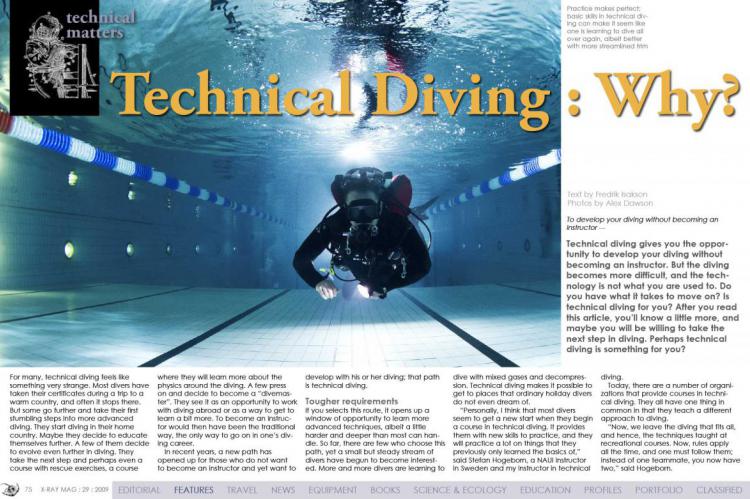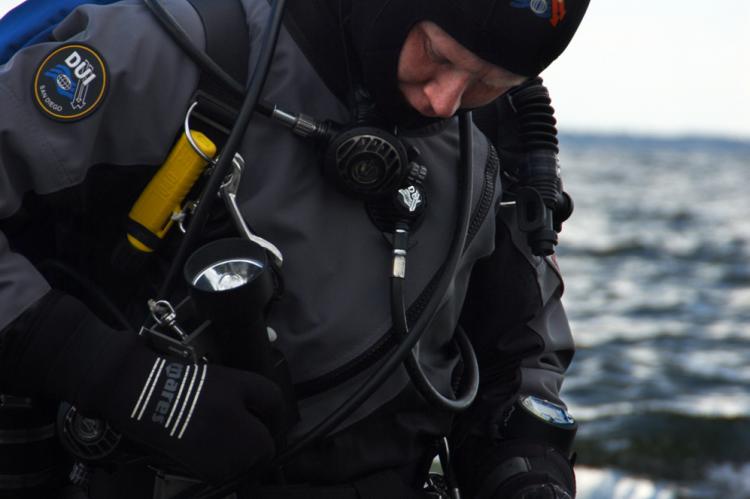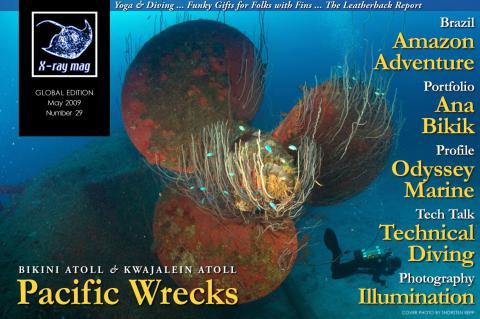Technical Diving: Why?
Technical diving gives you the opportunity to develop your diving without becoming an instructor. But the diving becomes more difficult, and the technology is not what you are used to.
Tags & Taxonomy
In recent years, a new path has opened up for those who do not want to become an instructor and yet want to develop with his or her diving; that path is technical diving.
Tougher requirements
If you selects this route, it opens up a window of opportunity to learn more advanced techniques, albeit a little harder and deeper than most can handle. So far, there are few who choose this path, yet a small but steady stream of divers have begun to become interested. More and more divers are learning to dive with mixed gases and decompression. Technical diving makes it possible to get to places that ordinary holiday divers do not even dream of.
“Personally, I think that most divers seem to get a new start when they begin a course in technical diving. It provides them with new skills to practice, and they will practice a lot on things that they previously only learned the basics of,” said Stefan Hogeborn, a NAUI instructor in Sweden and my instructor in technical diving.
Today, there are a number of organizations that provide courses in technical diving. They all have one thing in common in that they teach a different approach to diving.
“Now, we leave the diving that fits all, and hence, the techniques taught at recreational courses. Now, rules apply all the time, and one must follow them; instead of one teammate, you now have two,” said Hogeborn.
Come prepared
I was offer an opportunity to test out what technical diving could be for me, but I was extremely hesitant and refused at first, thinking that technical diving wasn’t for me. But after some persuasion, I decided to take the chance to see what it was.
I had never used twin bottles and hadn’t learned the techniques used for them. It was time to become a beginner again.
“I think that anyone who wants to try out technical diving should dive with twin bottles for a while before taking the next step. A short cut could be to enroll in an ‘intro to tech’ type course. It’s an orientation course for technical diving,” said Hogeborn. Most educational organizations have one.
Solid course
People starting with technical diving will probably have to learn to dive all over again. Everything is different, and yet, the same. Technical Diver, a NAUI course, includes 12 practice dives and a larger number of theory lessons. Technical Diver combines smaller classes into one larger course. It is a solid start to learning more about technical diving.
If the instructor awards you with your certification, which is not a given, the instructor believes that your skill set in diving makes it possible for you to start doing technical dives. It does not mean that you are a complete technical diver—a mistake young tough boys often make.
“After the course, you’re still a beginner, but with more skills than before. It is after your education that the real training begins,” said Hogeborn.
For me, the course gave me an opportunity for a new start in diving, new equipment, new gear and a different attitude to the “team”—your diving buddies. Suddenly, there are lots of new things to practice and new things to see, previously impossible to reach.
What is this?
The first few days, I just sucked in information. I kept my distance and studied my fellow students in the course; I was, after all, there to describe technical diving as a reporter as well. But slowly, I was sucked into actually learning, because it was so fun.
The team—my fellow students—consisted of Frida Drakling, Janne Henriksson and me. We were to become the team, or three group, of which a technical dive team consists.
It became quite clear to me that, even before the course, the other two students had been training on the principles and procedures that we were supposed to learn. In the beginning, it was to my disadvantage since I hadn’t been practicing them at all; everything was totally knew for me. But as the days passed, I caught up more and more.
Some things were easy for me to understand, others—mostly practical stuff—took a little bit more time to understand. But we complemented one another well and learned from each other. It was something we would benefit from over the days to come.
The course was structured in modules, skills in the water were mixed with theoretical lessons. In order to have time for our normal lives, we concentrated on our lessons in the evenings and on weekends. It would take us a few weeks before we had had time to do all the exercises and learn the theory.
A lot of theory
The first lectures of the course were mostly theoretical. Hogeborn told and showed us how to configure our equipment and what kind of equipment we had to use to be able to do the dives we were about to learn to do. It became clear to me that we were now leaving common recreational diving and moving into diving with higher complexity. What one brings under water was now on a large degree about redundancy.
This was also fun—much more fun than I first thought. I had always believed that technical divers were a little too interested in technology, that they had a tendency to talk a lot and mostly tinker with their gear, and that they found little or no pleasure from diving for its own sake. But I have found out that this is not so.
Most of the technical divers I meet nowadays have a more pragmatic approach to their diving than I first thought. Things are used, or sit where they sit, because they have a purpose, and there is always a proper reason for everything these divers bring under the surface; if there’s no reason for bringing it, they leave it behind.
Tinkering with your diving gear
The organization and care of a diver’s equipment is the foundation for good trim and correct technique. Hogeborn shows us how to adjust and correct our backplates and webbing, bottles and steel twinning bands. Each step leads to the next, and after a while, you wonder why you didn’t set up your diving gear ...
Download the full article ⬇︎

Originally published
X-Ray Mag #29
Bikini Atoll - Expedition to the wrecks of Operation Crossroads :: Aftermath — at the nuclear playground :: Journey to Bikini Atoll :: Wrecks of Kwajalein Atoll in the Marshall Islands. Leatherback Turtle Report from Papua New Guinea :: Profiling Odyssey Marine :: Yoga & Dive :: Tech Talk: Why Technical Diving :: UW Photography: Illumination :: Portfolio Ana Bikic



